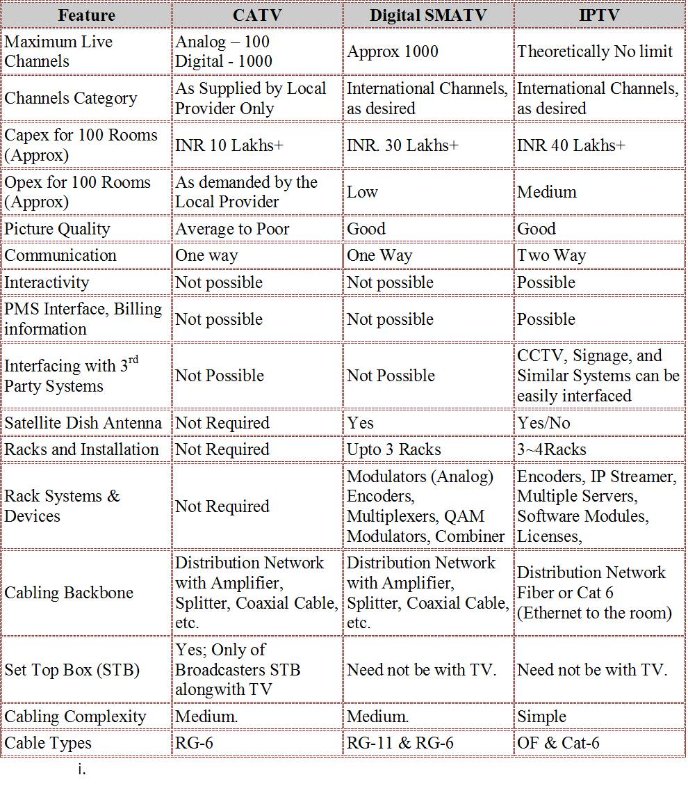- MATV (Master Antenna TV). Master Antenna Television or MATV, describes an analog cabling network which is used to distribute various television signals throughout a facility. With the installation of multiple satellite dishes, for centrally subscribing and distribution of any channel, from any part of the world (both Pay and Free TV services) can be delivered locally using the technology popularly termed as SMATV or Satellite Master
- CATV (Cable TV). CATV is nothing but the home-to-home Cable TV delivery using traditional coaxial cable connection to each of the residential premises to distribute TV from a central point or head end. CATV services are more or less irrelevant for large Hospitality properties, since majority of their clients may not require local channels.
- Antenna TV system. Thru installing MATV/SMATV capture and distribution infrastructure (popularly named as ‘head-end”), the property owner provides each room with a Set Top Box (STB) provided by the broadcaster, which is normally housed centrally at the head-end room to avoid accidental mis-tuning of channels by the guests. Each channel is modulated and distributed through the cabling network. Only a TV with remote is required in each room, and the entire channel array, shall be displayed locally. The traditional analog head-end system used to have several noise-generating components that affect the signal levels resulting in distortions in end-user TV signals like ghost images, snow, etc. Another issue of analog head-end used to its limited channel capacity. While, the maximum theoretical limit is 106 channels, practically, it never used to exceed 80 channels per system.
- Digital Video Broadcast SMATV. The above indicated drawbacks have been corrected in MATV systems based on Digital Head-end. Poor signal quality and 80-channel limitations have easily been resolved by converting the TV signal transmission from analog to digital (DVB). Using DVB set-top boxes, each channel is converted to digital RF into AV or HDMI, which is fed directly to the AV or HDMI port of the TV. However, improper selection and sizing of these head-end or its encoders can result in pixelisation and garbled TV picture. However, There is a significant cost in converting feed from analog to digital for encoders, QAM’s, etc. Local CATV services usually beams only local TV channels. Major benefit of SMATV over CATV is that, you can stream any TV services from any part of the world to your foreign guests/visitors.
- IPTV (Internet Protocol TV). IPTV is when the media-to-broadcast content is Ethernet. Using large internet bandwidth, various broadcasting contents like TV, telephone, signage, video on demand, high speed internet etc can be delivered to end-user using a single UTP cable. Also, IPTV is a two-way communication. This means a hotel guest can communicate to the main hotel server to retrieve information like on-spot bill, room service ordering, laundering, car rental bookings, and messaging. The possibilities of IPTV are almost endless. For eg: Menu cards can be translated into various international languages, to help the guests know about any dish that they wish to order. It can be in terms of calorific value, feel and look of a dish, preparation time and method. Further, centralized Remote management of set-top box of every room TV is possible. Each set-top box is individually addressable for any specific guest message or function.
- Importance of IPTV Sizing. Content delivery of IPTV requires right infrastructure planning. Such infra requires factoring of various operational requirements such as dissemination of number channels, services that are to be delivered, level of interactivity etc. Also, need to consider the convergence requirements of the project; say, the Data network, high speed internet, telephone services, signage, conferencing services etc shall share the same media, which will have tremendous Return of Investment (RoI). Towards this, only enterprise grade network hardware, having support to advanced streaming protocols are to be used on the network and are critical to handle the requisite “speed”, “compression”, “buffering”, “data processing throughput”, etc for a quality IPTV/Convergence infrastructure. Setting up of two parallel networks for IPTV and other IP services is not a good planning and is not going to be cost-effective.
- The above aspects have been tabulated for the Busy-Eyes below
